We are looking for this place: 2022

As we did last year, we begin this year 2023 with a compilation of all those places that we proposed you to find out each week in the section "We are looking for this place".
The solution, as always, can be found in the weekly newsletter that we share with you on Thursdays. But just in case any of you missed any of them, here are the 33 places chosen in 2022.

25 PHOTO SPOTS in the Pyrenees 📸
Access to map Google Maps 📌with the most emblematic locations in the Pyrenees mountain range.
We are looking for this place #41:
This week's place was sent to us by Manolo Perez. A beautiful place. We love these landscapes of the most intense green you can imagine and in which, sheltered by the rock, we can guess the presence of a small cave, do you recognise it?
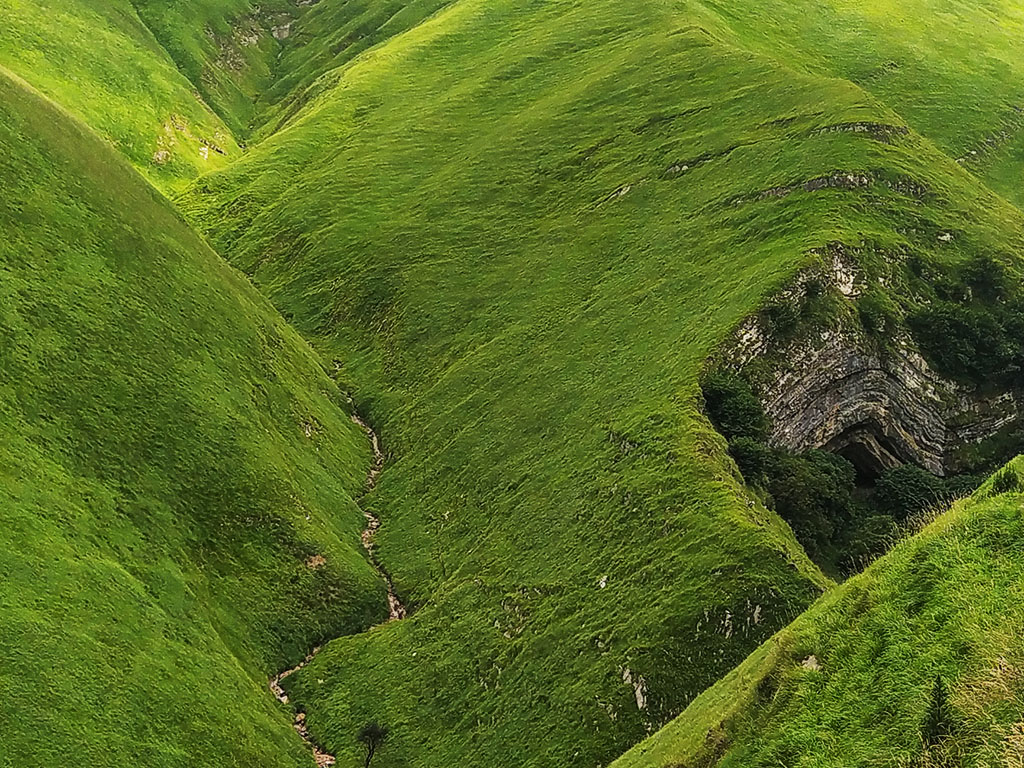
Tracks:
- It is located in the western Pyrenees, near Orbaizeta.
- It is close to a cave of great geological interest.
Solution:
The place was the cave of Harpea or Arpea, located at the head of the Errobi ravine, at the foot of Mount Errozate and a few metres from the border with Navarre.
There is nothing special about the interior of the cave, which is in fact used to keep livestock. However, its unique entrance sheltered by an impressive anticline, the beautiful surrounding environment and a climate that is always humid, give this place an enchanted aura. So much so that, according to legend, on hot summer afternoons some shepherds have seen lamias (mythological beings of beautiful feminine appearance but with animal feet) here.
We are looking for this place #42:
On this occasion, the photograph was sent to us by Alejandro Martín, who said: on this occasion, we don't want you to recognise what you see in the photo. I think we all know that. What we really want to know is where it was taken from. Not many places in the Pyrenees allow such a complete photograph of the Tres Sorores, Olas, Collado de Añisclo, el Zucón and the Tres Marías.
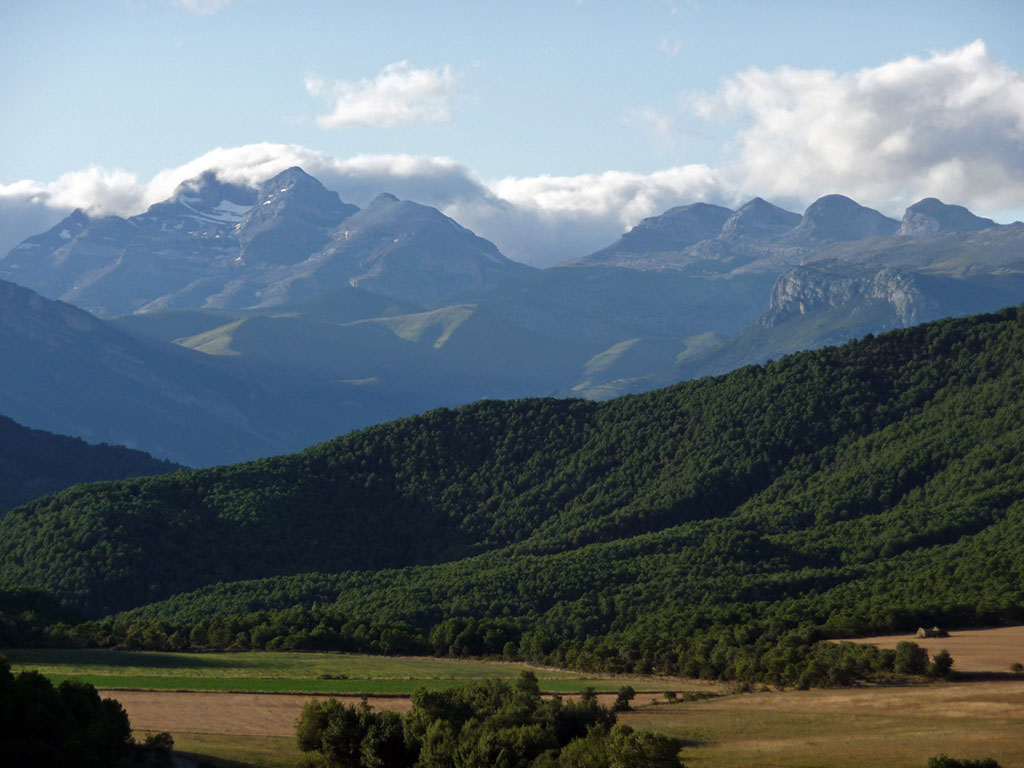
Tracks:
- The town is home to the monastery that claims to be the oldest in Spain.
- The town is built around a single central street.
- It is one of the main viewpoints of the Peña Montañesa; in fact, this village is always portrayed with it in the background.
Solution:
The photograph sent to us by Alejandro was taken from El Pueyo de Araguás. The perspective is very similar to the one seen from the bridge in Aínsa, although from here the view is higher. El Pueyo de Araguás, as well as being in a privileged location, has the honour of housing, according to some experts, the oldest monastery in Spain, the Monastery of San Victorián, of Visigothic origin (6th century). A good excuse to visit the place.
We are looking for this place #43:
This week's photograph was sent to us by Pau Grau Figuerola. The name of this 3000 means "bad pass", as in the past the glacier pass (now disappeared) and the summit were uncomfortable. Here are the clues that Pau gives us.
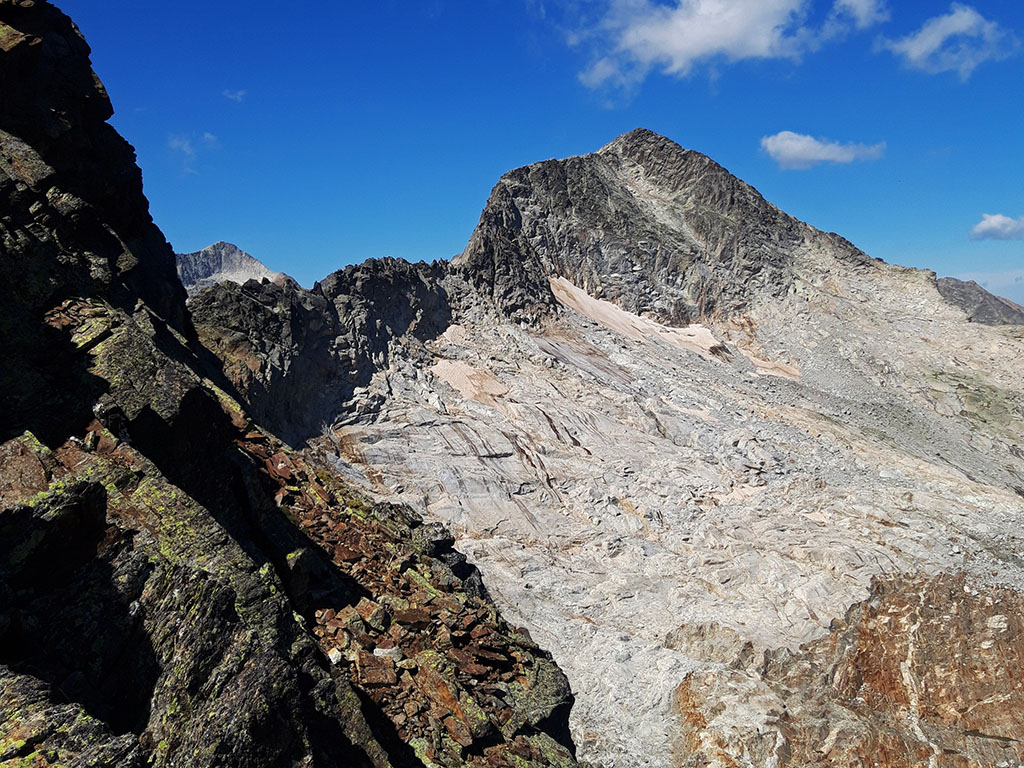
Tracks:
- Peak located between the Remuñe valley and the Lys valley.
- Next to it are two peaks named after two Aragonese mountaineers.
Solution:
The mountain that Pau Grau suggested we find was Maupas or Malpas, so called because of a bad pass that is found when climbing the northern slope, from the Maupas refuge. The photo is taken from the ascent to the peak of Boum, which has the particularity of being the most central three-thousand-metre peak in the whole Pyrenees, the most equidistant between the Balaitous and Pica d'Estats nuclei.
The first ascent of the Maupas, on 22 August 1825, was made by the geodesic officers Peytier and Hosard, who were in charge of carrying out work in the western sector of the Pyrenees for the new map of France to replace that of 1780. The Maupas was not their only first ascent of a great summit and, among others, that same year they climbed the Troumouse Peak, the Balaitous and the Palas on the ridge that came to be called the Geodesic Ridge, the latter by mistake when trying to conquer the Balaitous.
We are looking for this place #44:
We continue on the heights - be careful not to trip! This time the photography is by Nicolau Crespí, who adds the following clues:

Tracks:
- The summit is in the central Pyrenees surrounded by the highest peaks.
- Next to the summit in question is another of similar height, which is connected by a narrow, very sharp, overhead ridge. Impressive.
- ) From the top you can see an extensive panorama towards Posets, the peaks of Ribagorça and Pallars.
Solution:
The photograph sent to us by Nicolau Crespí, in which, if you look closely, you can see people crossing the Paso del Caballo, is of the Tuca de las Culebras. A place that many of you probably remember from the cover of Miquel Capdevila's mythical book of impossible times, "Los tresmiles en 30 jornadas" (The three-thousanders in 30 days).
We are looking for this place #45:
The photograph we are publishing this time was sent to us by Patxi Xabier Latorre. It is complicated, but with the clues you will surely be able to find it. It goes like this: Who doesn't like, between one physically demanding route and another, to dedicate a day to a relaxing stroll, to visual enjoyment and to the simple enjoyment of those small details (a rustic boulder, the song of a bird, a rare flower...) that in other circumstances go unnoticed? This is an unbeatable place to forget about rushing and challenges.
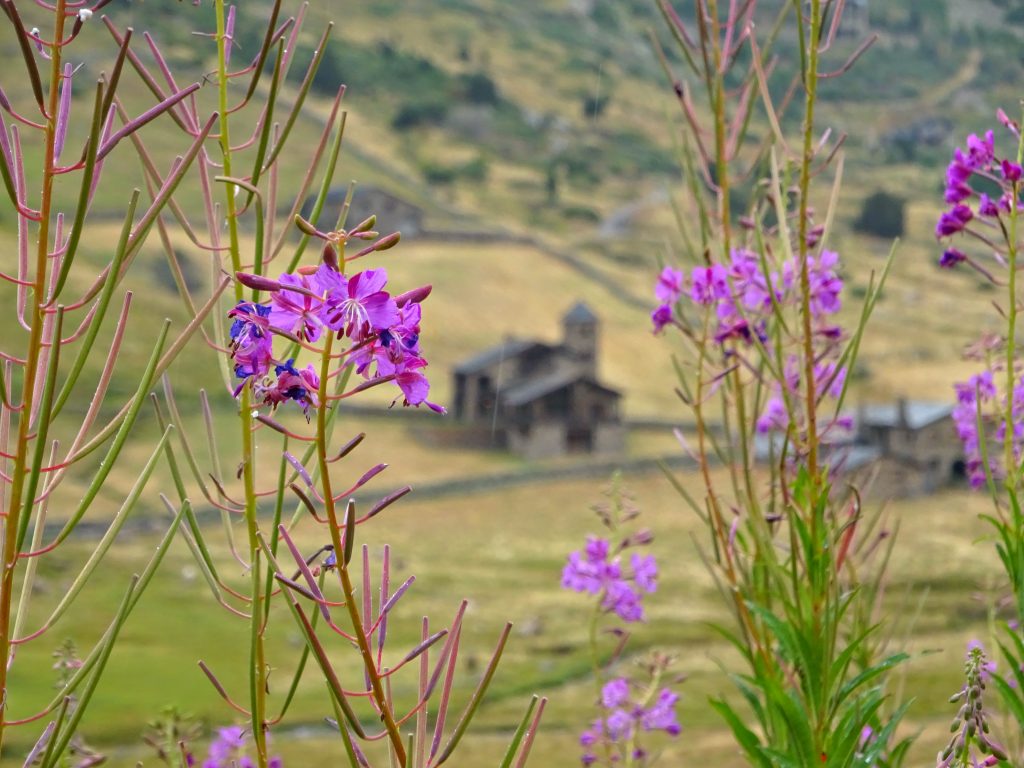
Tracks:
- A pleasant and simple family route that runs along the bottom of a small, bucolic valley.
- It is located near the highest asphalted mountain pass in the Pyrenees.
- It is neither in France nor in Spain.
Solution:
Last week's solution is the Camí de l'Obac, in the Vall d'Incles, which is also the path of the High Pyrenean Route. The Camí de l'Obac is a small path that runs through the Vall d'Incles and is usually combined with the narrow road that runs parallel to it, on the other side of the river, to make a circular route of 6 kilometres. By the way, the flowers that appear in the foreground, in case anyone had wondered, we believe that they are narrow-leaved willowherb or Saint Anthony's laurel.
We are looking for this place #46:
The photo of this great Pyrenean colossus was sent to us by Julia García. A mountain that stands out for its enormous size and isolation, do you recognise it?
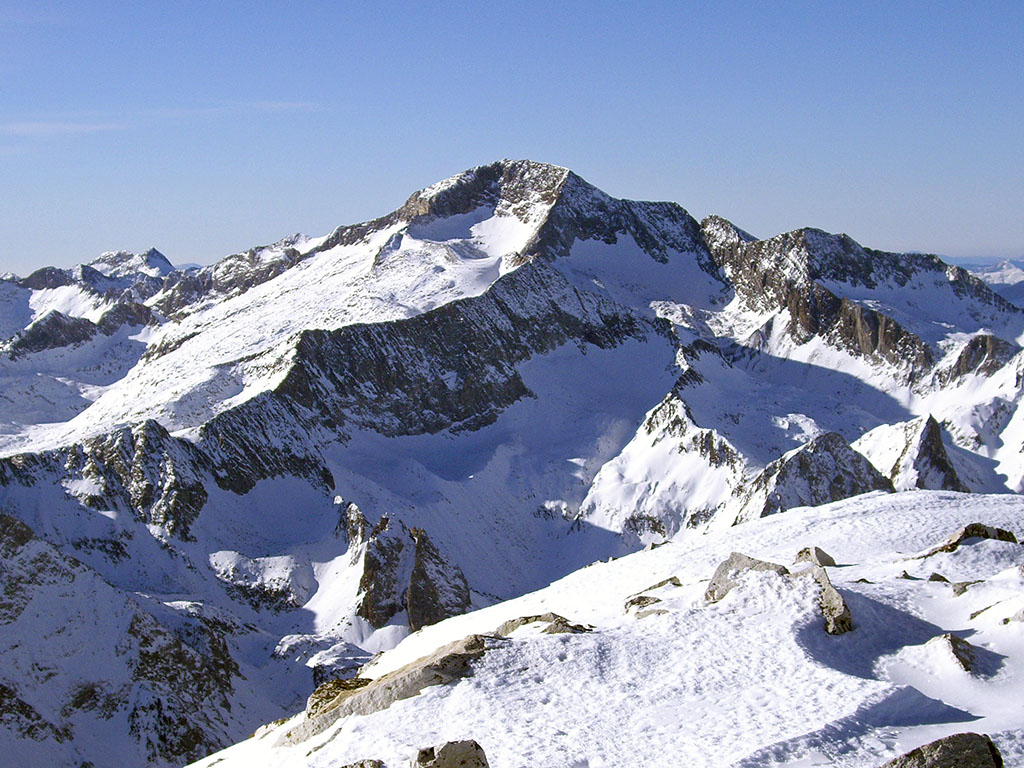
Tracks:
- We will tell you which one it is not, the Perdiguero. The photograph was taken from here.
- It is not the lack of rock but the mediocre quality of the rock that makes this mountain unattractive for climbers.
- There are three usual starting points to reach the summit, although the vast majority choose the comfort of the modern refuge on the southern slope.
Solution:
Last week's photograph, taken from the summit of Perdiguero, is of the Posets massif, the second highest in the Pyrenees at 3,368m. Although most mountaineers choose to climb Posets on the southern slope, from the Ángel Orús refuge, there are other alternatives with shelters on the western slope (Ref. de Viadós) and on the northern slope (Ref. de Estós), which also allow a circular route around the massif or a circular route around the mountain. Route of the three refuges.
We are looking for this place #47:
This week's photograph was sent to us by Pau Grau Figuerola, who repeated his participation. The place he proposed to find was a shelter, which, if you look closely, can be seen above the gap, the dark rectangle.
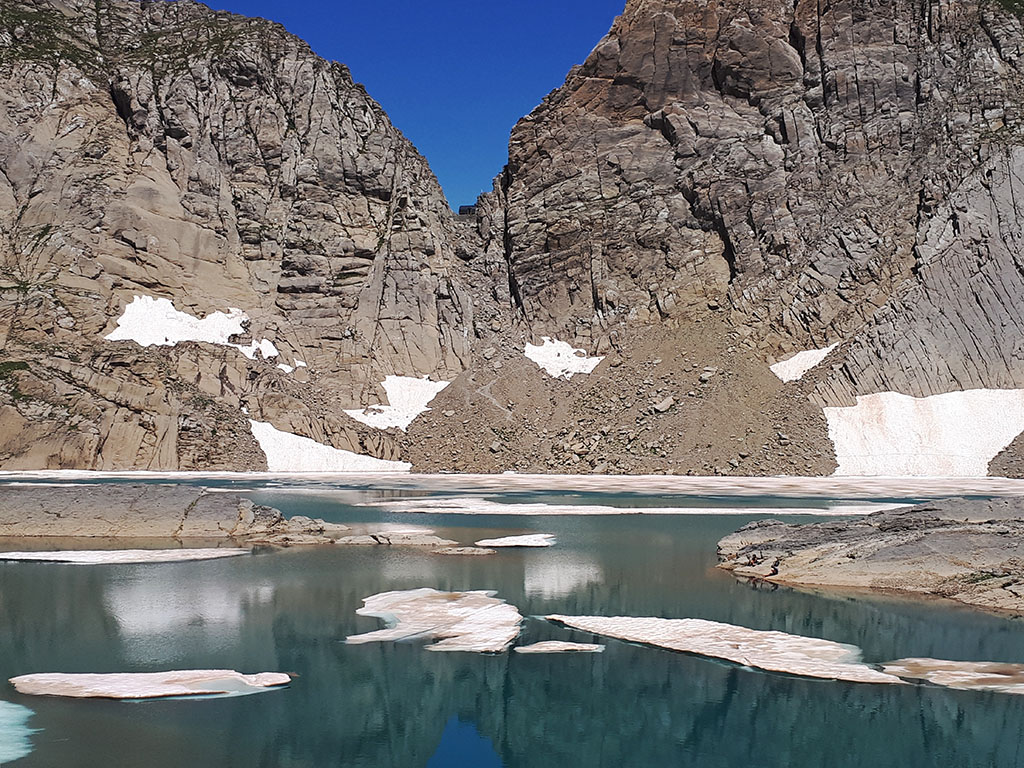
Tracks:
- The gap gives its name to the refuge.
- It is the oldest refuge in the Pyrenees, built in 1890 by the French Alpine Club of Lourdes.
Solution:
This week's place was the Tucarroya hut. The oldest refuge-construction in the Pyrenees with the permission of the observatory hut of the Pic du Midi Bigorre, on the Col de Sencours. The refuge was completed on 30 September 1889 and solemnly inaugurated on 5 August 1890. A large group of personalities, including members of parliament, mayors, presidents of mountain clubs, and famous Pyrenean mountaineers, attended the ceremony. On a curious note, the attendees enjoyed a menu that today would be considered a prison menu: Monte Perdido chamois, Arazas mountain goat or capercaillie pâté, among other delicacies.
We are looking for this place #48:
The photograph this time was sent to us by Miguel Hernández, a winter picture at the foot of the Pyrenean monarch in which we asked you for the name of this mountain.
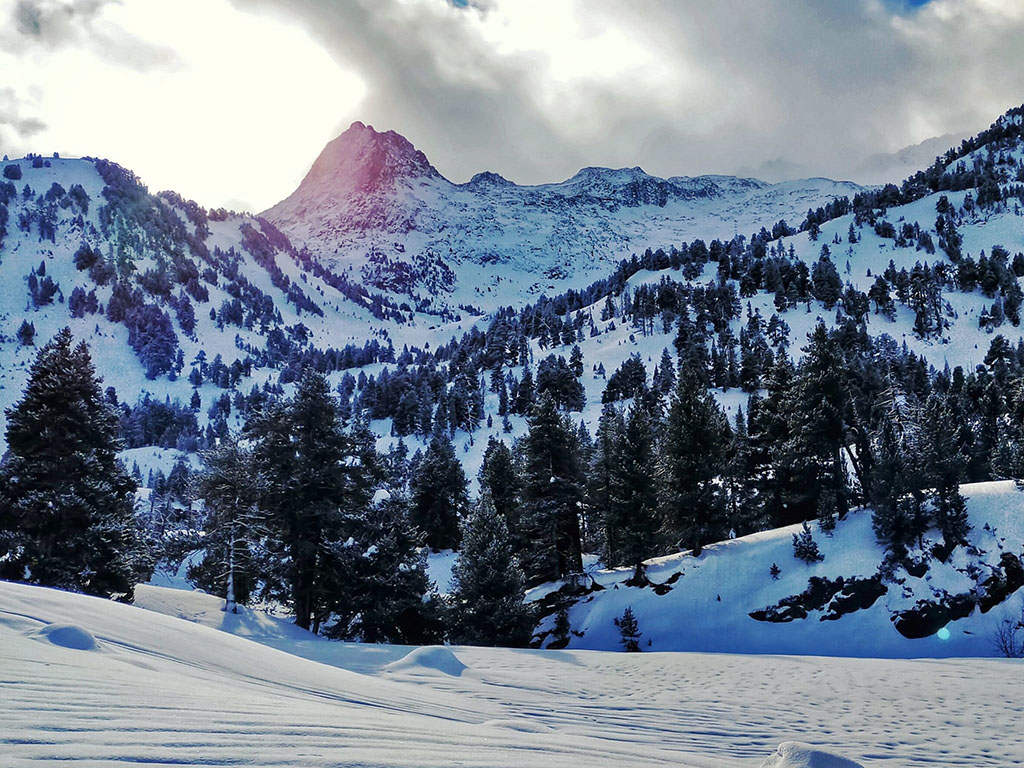
Tracks:
- Although seen from here the mountain we are looking for is imposing, its height is very modest for the area in which it is located.
- At its foot is the refuge of the same name.
Solution:
The mountain we were looking for was the Tuca de la Renclusa (2,685m). This is the first bastion of a long ridge that continues with the Cresta de los Portillones and ends at the Maladeta at 3,313 metres.
We are looking for this place #49:
Taking advantage of the last snowfalls, if the mountain allows it, there are good opportunities to go out with snowshoes for a walk or climb to the top of a mountain, like the one in the photograph in which we asked you for its name.
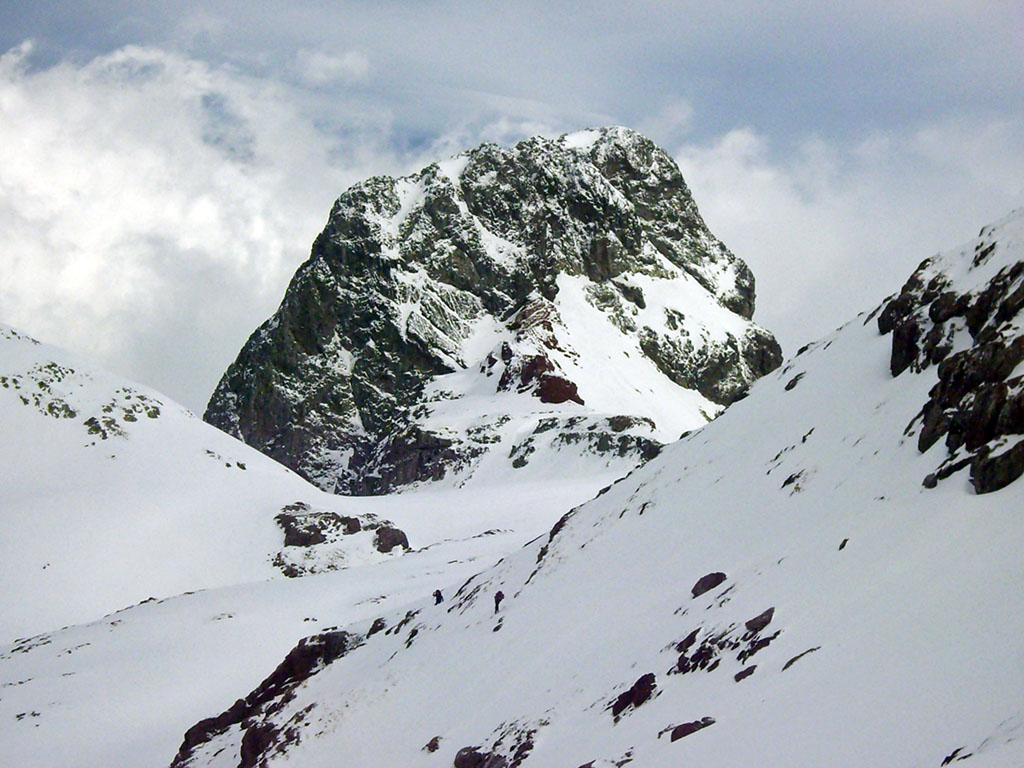
Tracks:
- This airy peak is actually the last standing remains of an ancient volcanic chimney.
- His older brother is French.
Solution:
The place this week was the peak of Anayet (2,545m), the remains of an old volcano originating 300 million years ago, long before the formation of the Pyrenees between 85 and 24 million years ago during the collision of the Iberian and European plates.
The ascent to the peak of Anayet is one of the most classic ascents in the Western Pyrenees. The normal route (F), visible in the photograph, is exposed and is equipped with a chain. Climbing routes are not abundant due to the poor quality of the rock, however, the North and the Corredor de los Franceses are two classic winter climbing routes.
We are looking for this place #50:
In a world driven by economic interests, we wonder what is the value of places like these that we ask you to find out about each week. Do they have a price? Are our insignificant lives worth more than the land we inhabit? Luckily this week's place is "safe", protected by the figure of a Natural Park, perhaps there is nothing profitable to be gained.
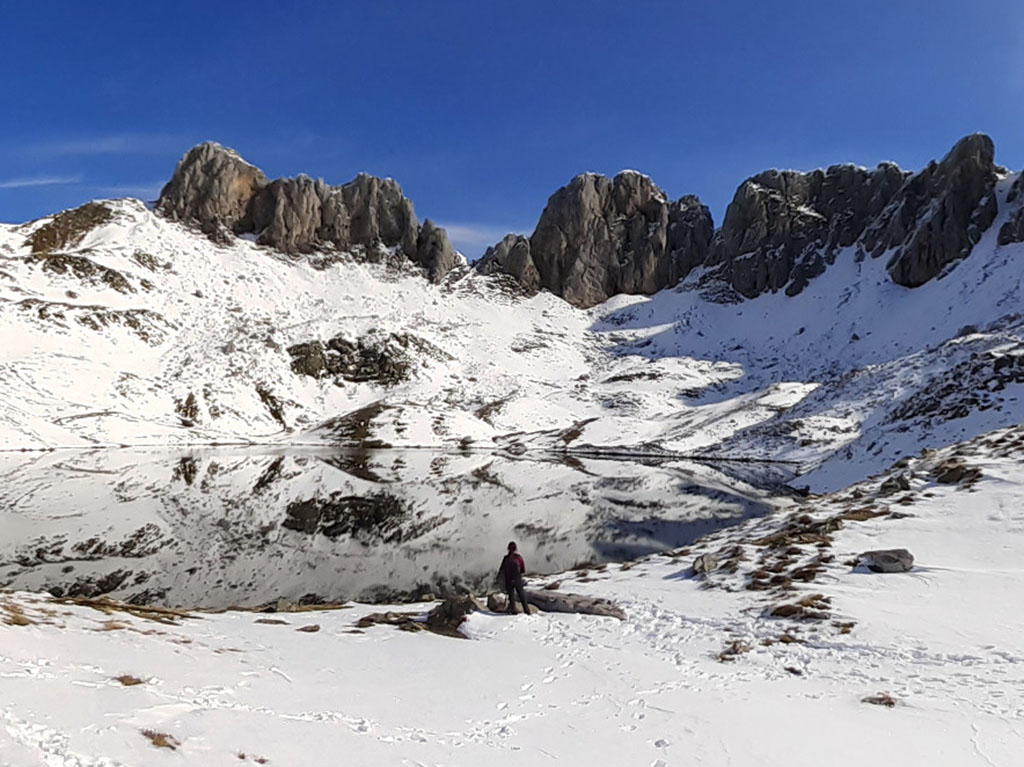
Tracks:
- This is one of the westernmost lakes in the Pyrenees.
- It is located at an altitude of almost 1900 metres.
Solution:
This week several of you have written to us with the correct answer, the ibón de Acherito. The truth is that it is one of those places that you have to visit and of which some time ago we shared with you a circular route fully signposted (5h; 11kms; +/-750m). A good excuse to visit the Valles Occidentales.
We are looking for this place #51:
This week Pau Grau, a mountaineer who keeps sending us places, sent us this photograph accompanied by the following clues:
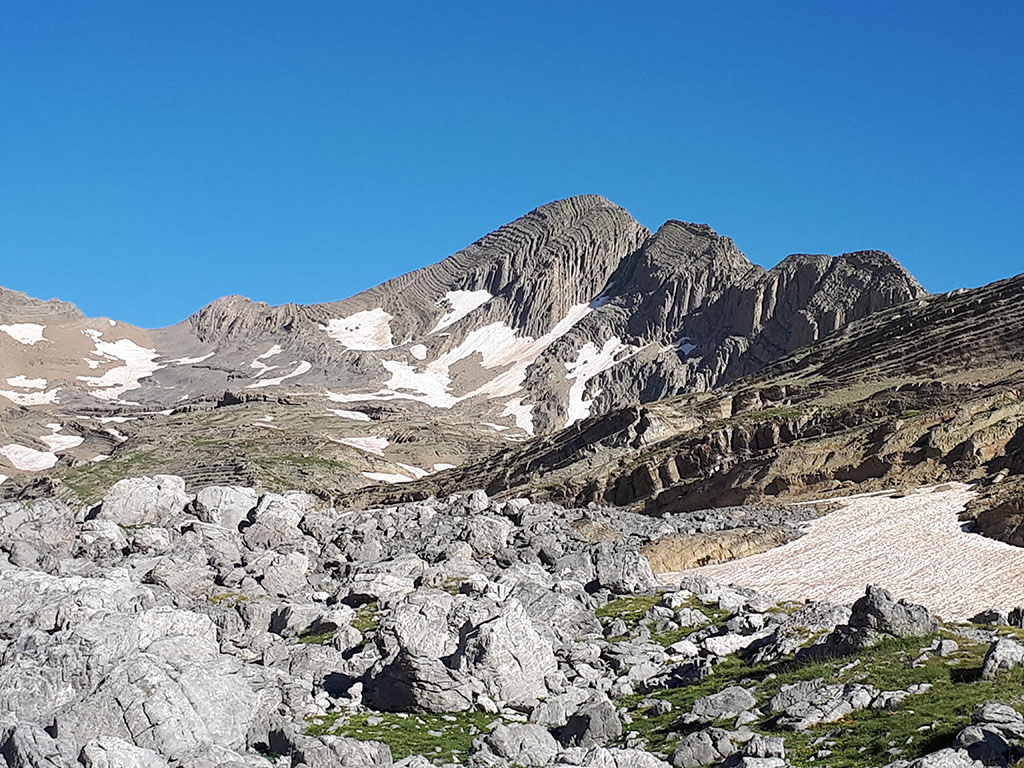
Tracks:
- It is accessed by the most beautiful balcony in the whole Aragonese Pyrenees.
- Both this beak and its little brother have a very characteristic morphology.
Solution:
The place we were looking for was the Gran Astazu or East Astazu. Next to it, from left to right we can identify the Astazu pass, the Pequeño Astazu (3,013m), the Swan pass and the Gran Astazu (3,071m). This is a totally different perspective to the one to the north, and to the other side they show the appearance of twin peaks that plunge into the valley with a 500-metre wall, interrupted only by the famous Swan corridor.
We are looking for this place #52:
This week's photo was sent to us by Nicolau Crespí, an old friend of this section with whom we travelled some time ago to the Vallibierna. On this occasion he suggests we find the valley that stretches out at his feet, literally. Let's go there with the tracks!
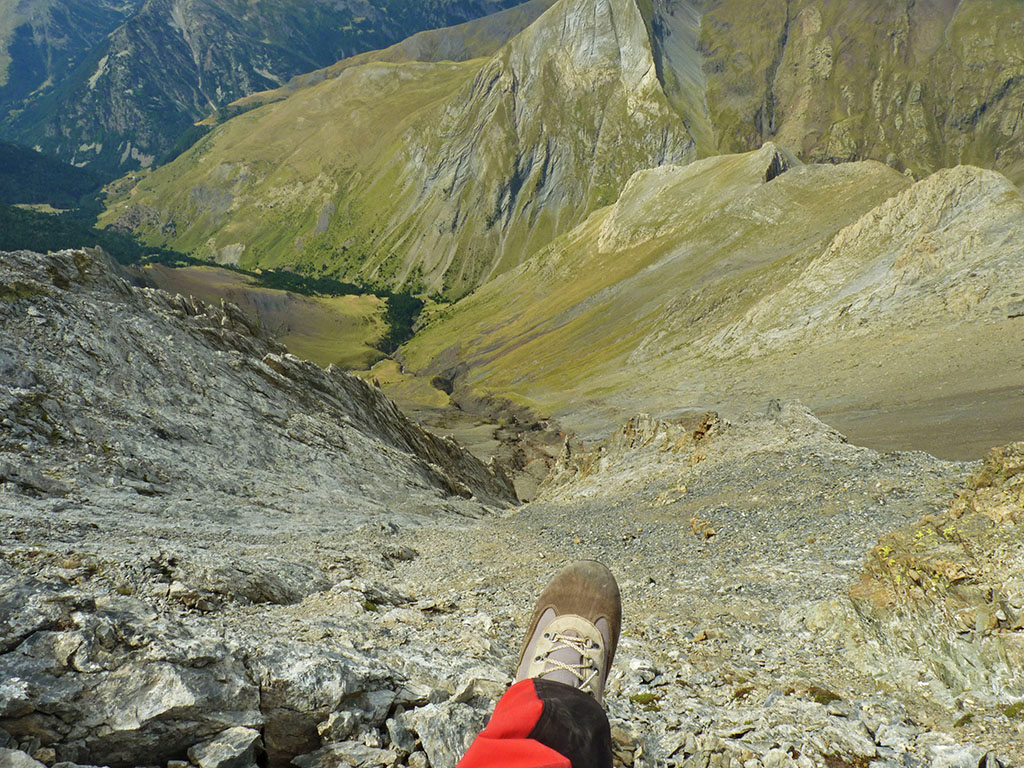
Tracks:
- This place is located in the heart of the Aragonese Pyrenees.
- It is accessed from two important refuges in Aragon and within a Natural Park.
- It is a part of the GR11.
Solution:
The place we were looking for last week was the Chistau valley. More specifically, in the photo taken near the Pico de la Montañeta/Veteranos, we could see in the foreground the Pala ravine with the Cinqueta de Añes Cruces valley below, and how it joins the Cinqueta de la Pez in the forest area to form the Cinqueta. With a bit of imagination we could also see the Biadós farms and the refuge itself, the starting point for many of the mountains in the area and an obligatory stop on the Pirenaca Trail.
We are looking for this place #53:
We travel once again to the Aragonese Pyrenees with Pau Grau, who once again takes part in this week's search. This time he proposes us to find this beautiful blue water lake that seems to be taken out of a fairy tale.
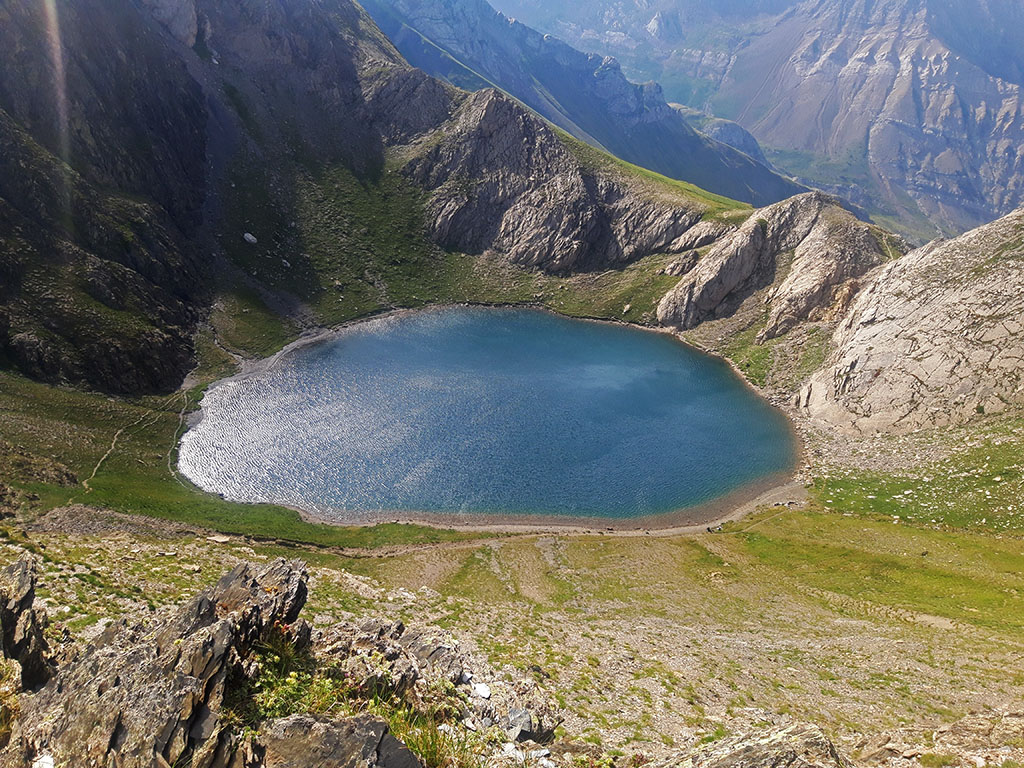
Tracks:
- It is one of the most beautiful and visited lakes in the Aragonese Pyrenees.
- The Ibón has the same name as its peak.
- Historical border crossing point and a reference point for transhumance in summer.
Solution:
Last week's place was the Ibón de Bernatura. One of the most accessible excursions in the Bujaruelo area and which can be completed by climbing the peak of the same name, from where the photograph is taken.
We are looking for this place #54:
The mountain we're looking for this week might go rather unnoticed if it weren't for the tusk sticking out of its left side. Recognise it?
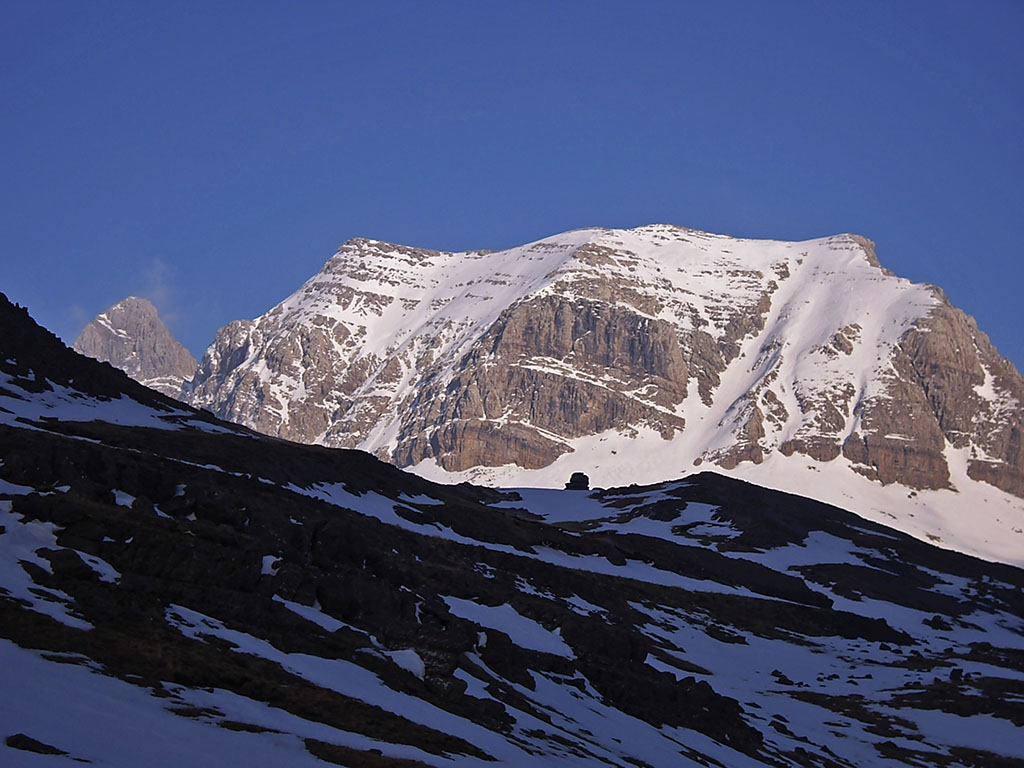
Tracks:
- Its elongated summit is located on the dividing line of two important Pyrenean valleys.
- This is an unfrequented mountain, with a long approach walk and a considerable slope.
Solution:
The mountain we were looking for last week was the Pico Balsera, also known as Hombro de Escarra. It is located between the valleys of Aragón and Tena, closing the cirque of Ip to the East, where some time ago we brought you a route to climb it from Canfranc next to its best known neighbour, Punta Escarra.
We are looking for this place #55:
This time the photograph was sent to us by Pau Grau, one of the regulars in this section. This time the place we were looking for was this rocky peak with a greyish appearance, from what we deduce, it is a limestone mountain. Let's go there with the clues that Pau sent us:
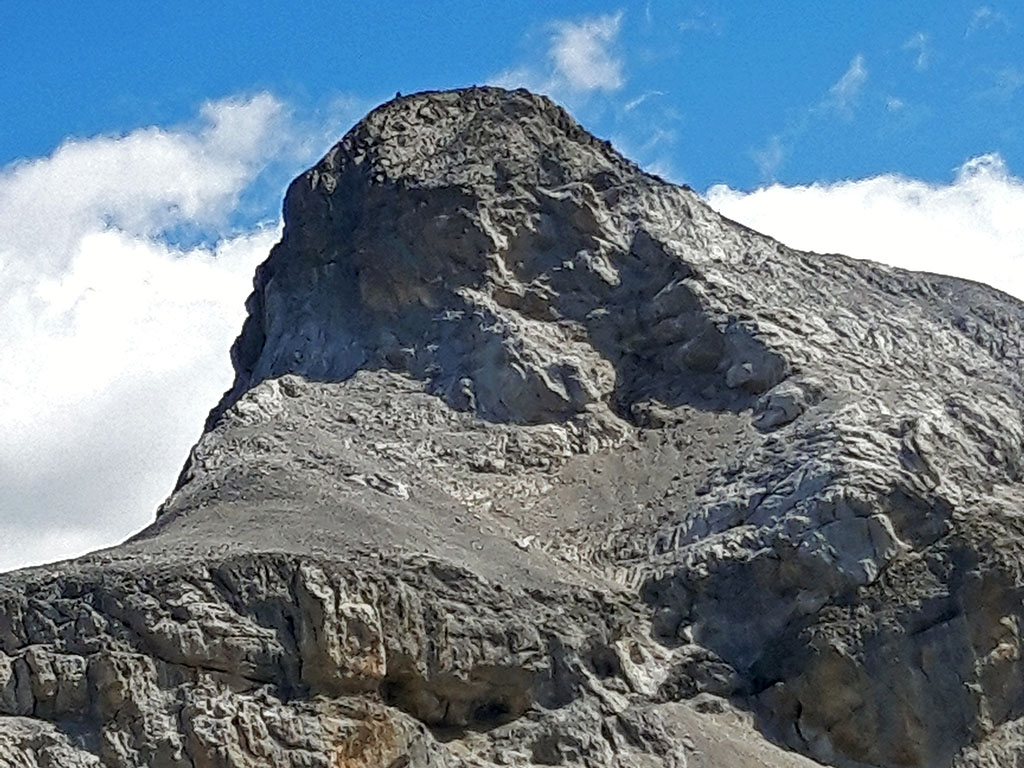
Tracks:
- The summit can be reached by a famous "pass" or by an underground chimney (cave).
- From the summit you can see the highest waterfall in France.
Solution:
This week's peak was Casco de Marboré (3,006m), a mountain well known for being next to the famous Rolando Gap. The name Casco comes from the description of the mountain by Count Russel, the first known person to reach its summit together with Killough in 1865, who described it as a mountain with a military appearance, with a steel helmet. Although it seems that in France our mountain did not have a name at that time, in Aragon it was already known as "Corral Ziego".
We are looking for this place #56:
This week we travelled with Aitana Casanova to one of the most outstanding summits in the Western Pyrenees, and with this you have the first of the clues. Let's go on with the rest:
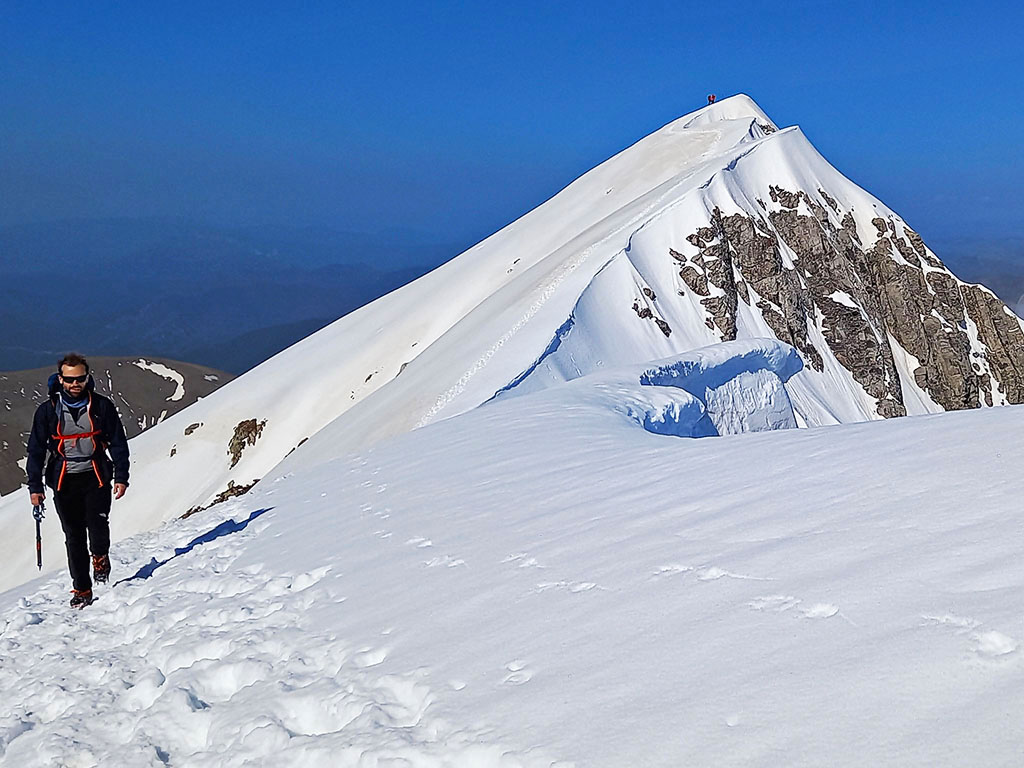
Tracks:
- It measures 2670m and is the highest peak in the Jacetania region.
- It is the first peak that exceeds 2600 metres altitude if we come from the Atlantic.
Solution:
This week's photograph was of the summit of Bisaurín (2,670m), the giant of the area. It is a very well-known and popular mountain all year round, ideal for climbing on skis in winter or for beginners in the "two-thousanders" in summer. The most common routes start from the Lizara refuge and the Gabardito refuge, following the GR11.1 variant to the Foratón pass.
We are looking for this place #57:
This time we travelled with Nicolau Crespí to the Eastern Pyrenees in search of this mountain in the foreground. A place that, as you can see, is located in an important area of lakes. Let's take a look at the clues that Nicolau sent us!
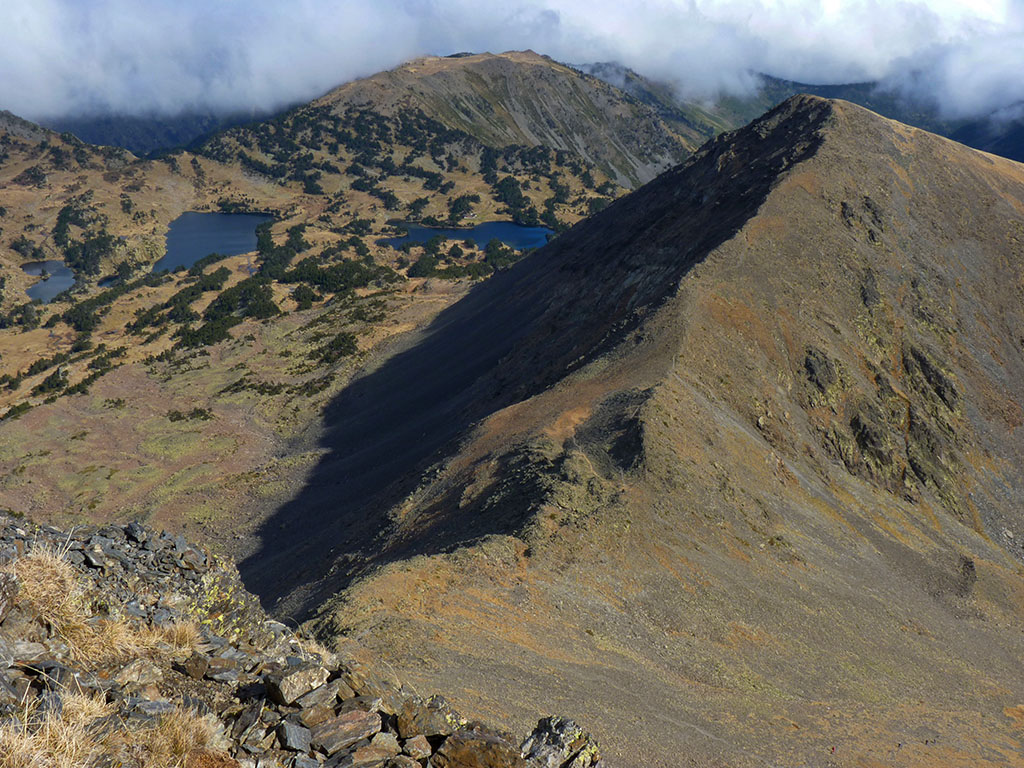
Tracks:
- The peak in question is well known to Catalan hikers.
- It is located in the Capcir region (France).
Solution:
The peak we see in the image is Petit Peric (2,690m). The photograph is taken from the ascent to Puig Peric (2,810m) with Estany Gros and Estany del Mig in the background. The place is located in the Eastern Pyrenees, to the north of the Carlit massif, in an outstanding area of lakes, damp forests and arid ridges...
We are looking for this place #58:
What a wall! Just imagining the adventurous terrain that these walls offer for mixed climbing is frightening. You have recognised its unmistakable silhouette of a truncated pyramid, haven't you? Ahh, you don't! Then with the help of the clues you certainly will. Here they go:
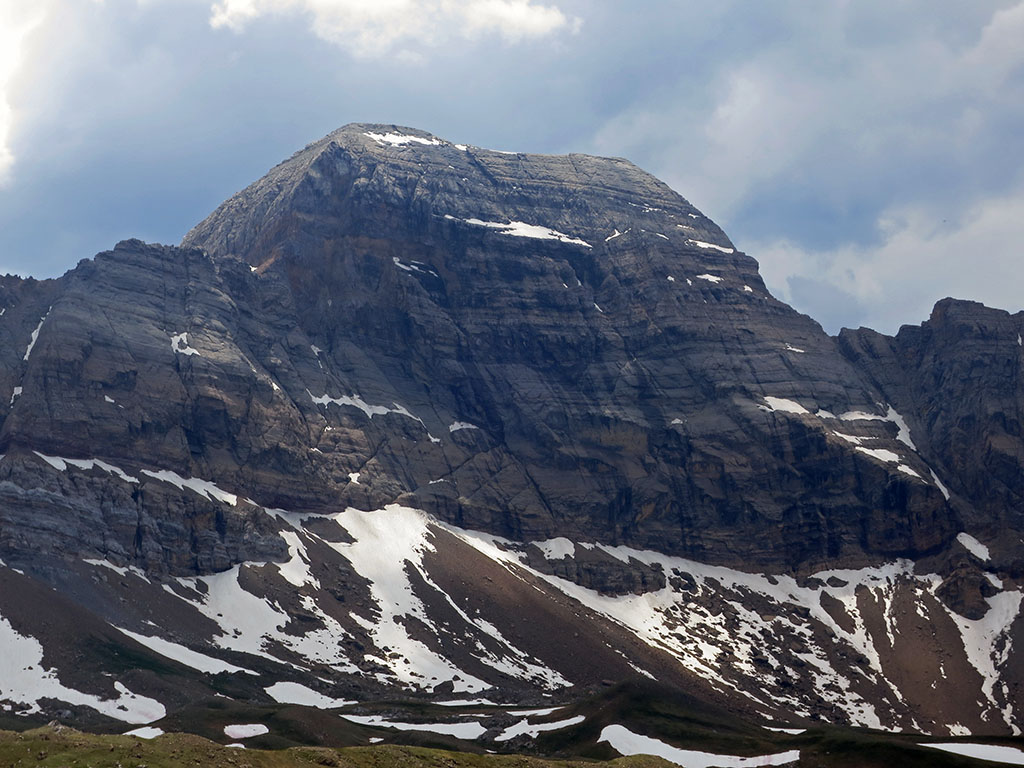
Tracks:
- It is located in the Western Pyrenees, in Huesca.
- We will take the most famous train station in the Pyrenees as our starting point for the ascent.
- On the southern slope is the lake of the same name.
Solution:
Last week's spot was Pala de Ip (2,783m), one of the most beautiful climbs in this part of the Pyrenees and yet one of the least frequented. If it is still on your list of mountains to climb, we advise you to choose an itinerary that goes along the easy ridge that joins it with La Moleta, like this one here, with ascent through the Izas canal and descent through the Elvira spring.
We are looking for this place #59:
From the snow-capped peaks to the valley floors, the Pyrenees offer a host of nooks and crannies waiting to be discovered by the traveller. Such is the case of the gorge shown in the photograph, which, thanks to the footbridges that facilitate access, is very easy and pleasant to walk through with the little ones as a family.
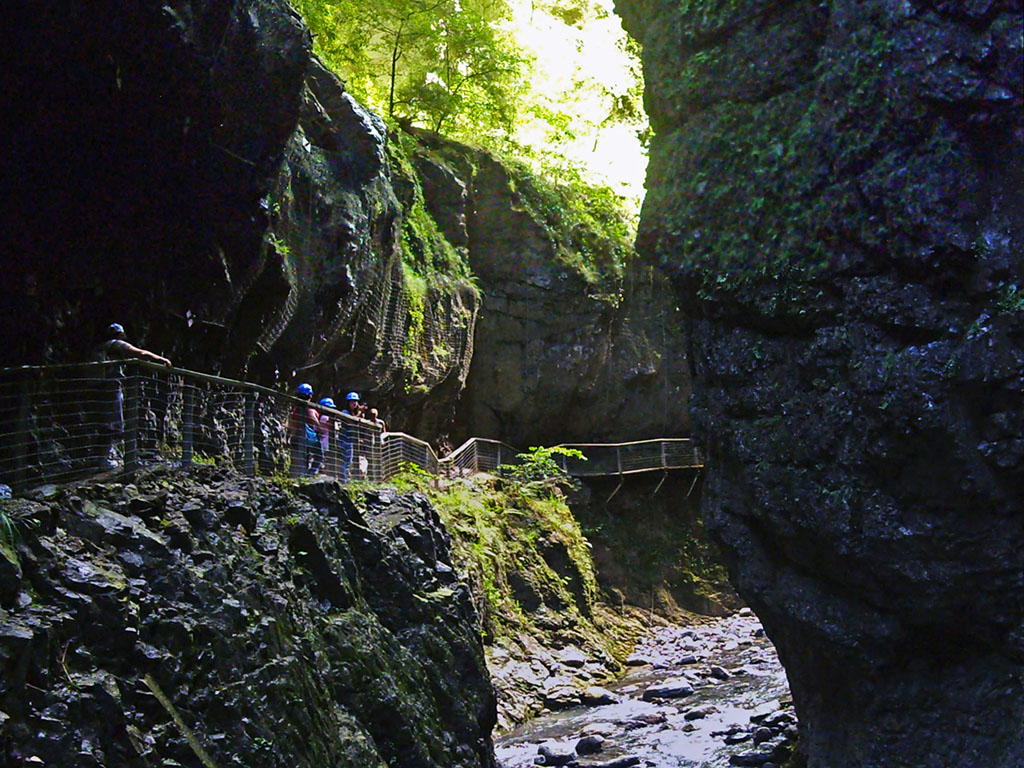
Tracks:
- The humid wind from the Atlantic and the narrowness of the place make this ravine a place of exuberant vegetation.
- The waters of this ravine end in the Cantabrian Sea.
- The route was refurbished and opened to the public in 1967.
Solution:
This week's location was the Kakueta Gorges or Gorges de Kakouetta, located in the French Basque Country, near the village of Santa Grazi. The route through the interior is very easy (2kms one way) and can be done with children. If you want to visit them, you should know that they are open from March to November and you have to pay an entrance fee.
We are looking for this place #60:
The photo this time is from a few years ago, 2009 to be precise, as I'm sure many of you have guessed from the absence of the walkways that surround this small and fragile ecosystem.
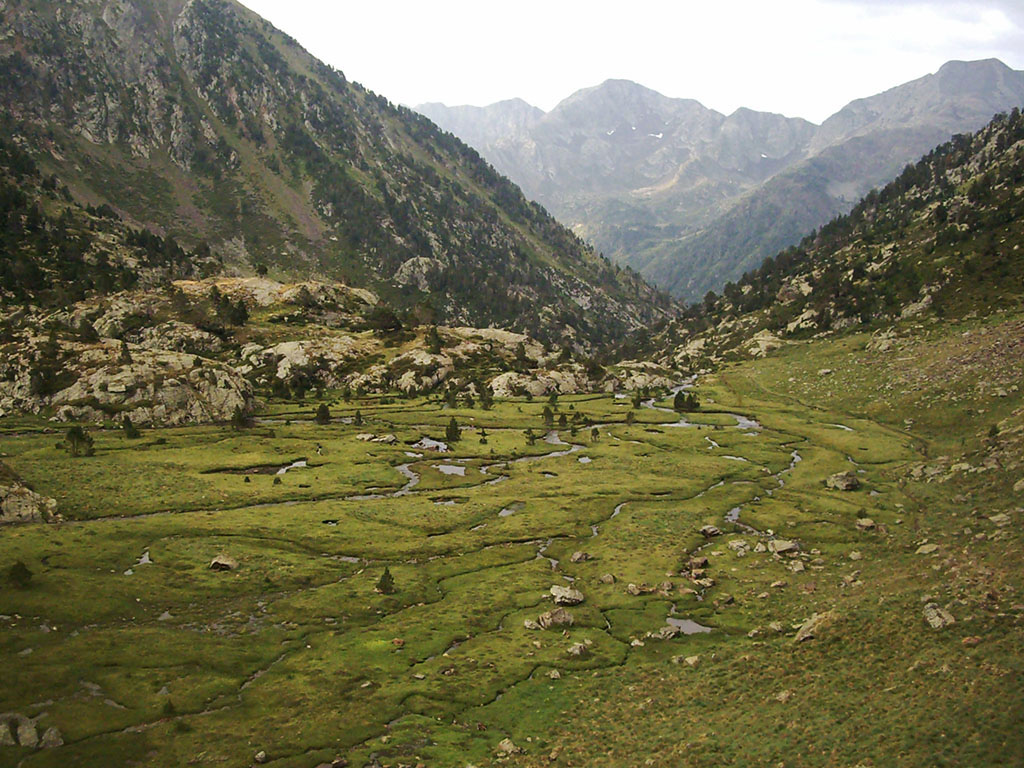
Tracks:
- It is located in the Alt Pirineu Natural Park.
- It is a regular stopping place to reach one of the most prestigious peaks in Catalonia, if not the most prestigious.
- The name of this plan is named after the tresmil that dominates this place.
Solution:
The place we were looking for was the Plans de Sotllo peat bogs. A site of high ecological value in which the masses of sphagnum trees stand out, a rarity that is difficult to see in the Pyrenees, more typical of Atlantic and northern European areas.
In 2017, to protect this place from the more than 5,000 visitors who each year climb the Pica d'Estats following the route from the Vallferrera refuge, wooden walkways were installed as part of the project LimnoPirineus of the European Union's LIFE programme.
We are looking for this place #61:
Step by step, after ascending 900 metres in altitude, the group has dispersed and each one faces the last few metres at their own pace before reaching the hermitage that crowns the summit of this mountain, one of the most outstanding in the mountains of Navarre.
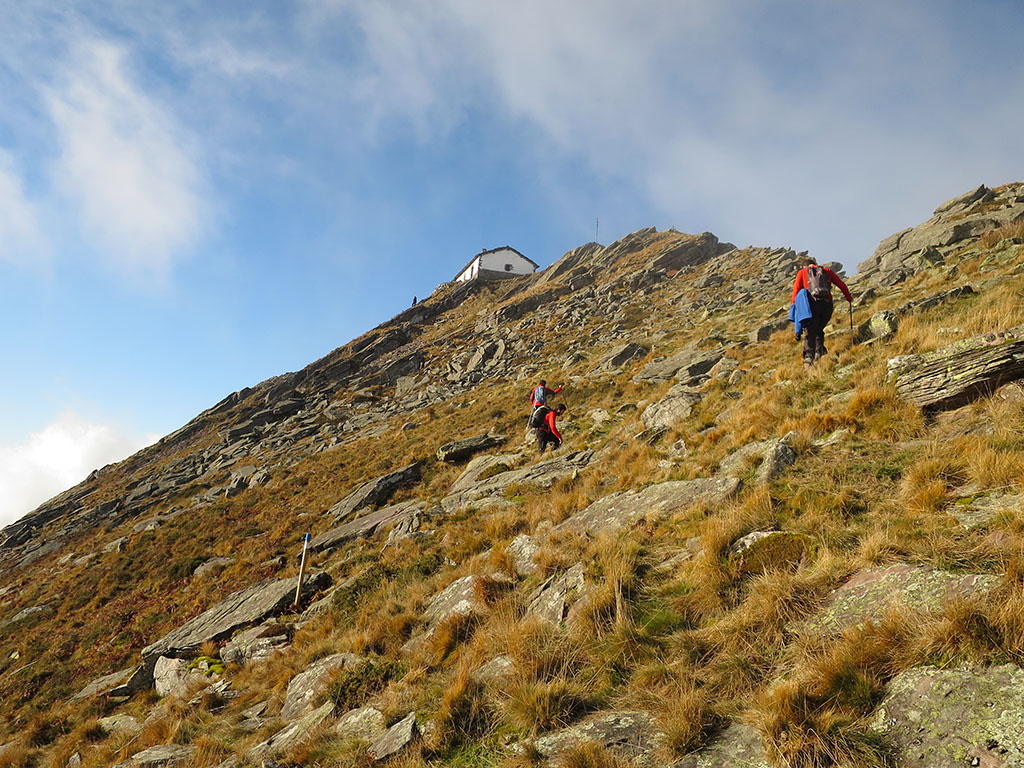
Tracks:
- The hermitage at the top of the hill is dedicated to the Trinity.
- This peak is located in the most Atlantic area of the Navarrese Pyrenees, to the north of the Cantabrian-Mediterranean divide.
Solution:
This week's photograph was of Mendaur (1,131m), in the Atlantic area of Navarre. Although it is undoubtedly a mountain of very modest height, its proximity to the Cantabrian Sea means that we can find a difference in altitude of 900 to 1000 metres on any of its normal routes. At its summit there is a hermitage dedicated to the Trinity from 1963, built on top of the previous one from 1693, which is reached after climbing 60 steps.
We are looking for this place #62:
No climber passing by this place has ever escaped the unbridled call to climb - someday - the perfect lines that criss-cross these granite spires. Do you recognise them?

Tracks:
- They are located in the Benasque valley.
- The photograph is taken from one of the variants of the GR11.
Solution:
This is the Perramó Needles, one of the most iconic mountains in the Benasque Valley. The needles are made up of two main peaks, the eastern one, the most slender and difficult (AD+) and the western one, the highest and easiest (F). In any case, even if we don't climb, visit the lake environment of Batisielles and Perramó is a highly recommended excursion.
We are looking for this place #63:
We love mountain lakes, whether we call them ibones, estanys, estanhs or lacs, as in this case we have travelled to a place in the French Pyrenees. Can you tell us which place it is?
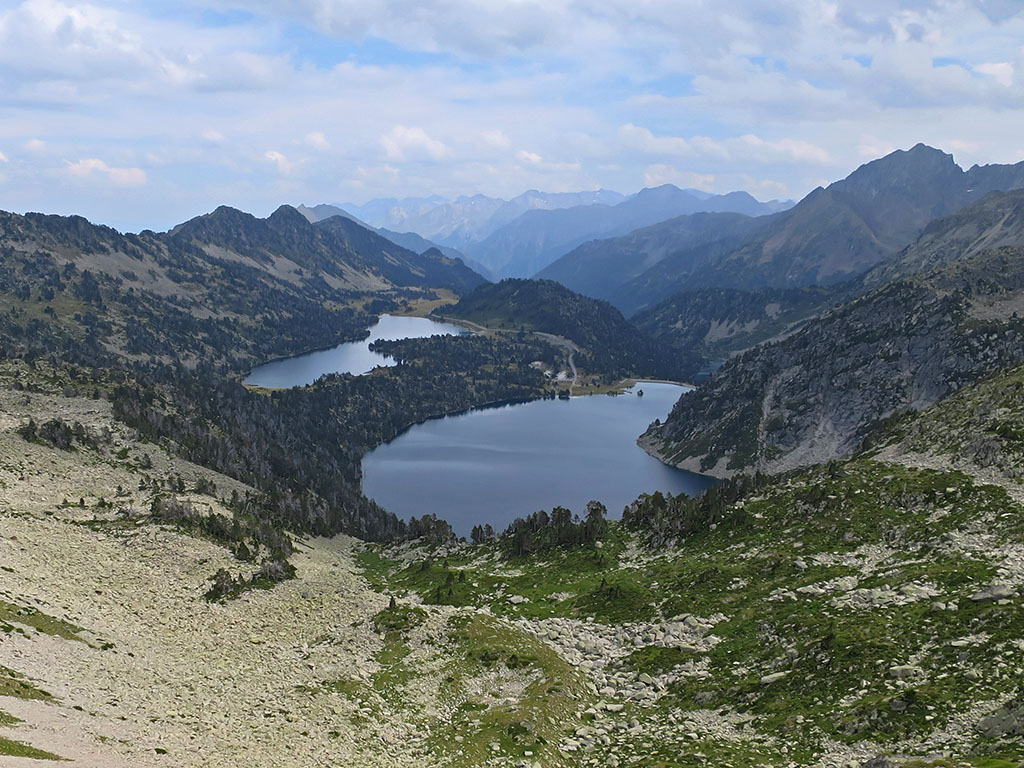
Tracks:
- This is an exceptional site, one of the first protected areas in France. It was declared a nature reserve in 1936 and became part of the Pyrenees National Park in 1968.
- This massif of perpetual snow, as the name of this nucleus of mountains reminds us, is distinguished by its affiliated granite ridges, its landscapes modelled by the powerful erosive action of the glaciers and, of course, by its abundant lake areas.
- Road cycling enthusiasts will find here one of the toughest climbs in the Pyrenees. A pass that has never been climbed in the Tour de France due to the fact that it is located in a protected area.
Solution:
The two lakes in the photograph were the lakes of Aubert and Aumar, located in the Neouvielle nature reserve. Both lakes are at the foot of the Pic de Neouvielle (3,091m), which, although it is not the highest, is the best known and most visible of the three mountain peaks in the reserve and the one that gives its name to the massif. The name Neouvielle comes from the Occitan nèu vielha, i.e. old snow. Today, the name no longer does justice to this place where the glacier has been reduced to a more or less persistent snowdrift...
We are looking for this place #64:
After a summer break, we resumed our weekly search in style, with this beautiful photo sent to us by Iker Ortiluzu, who added the following clues.
We are in one of the most beautiful places in the Pyrenees, visited both by hikers and snow lovers, being one of the most visited areas.
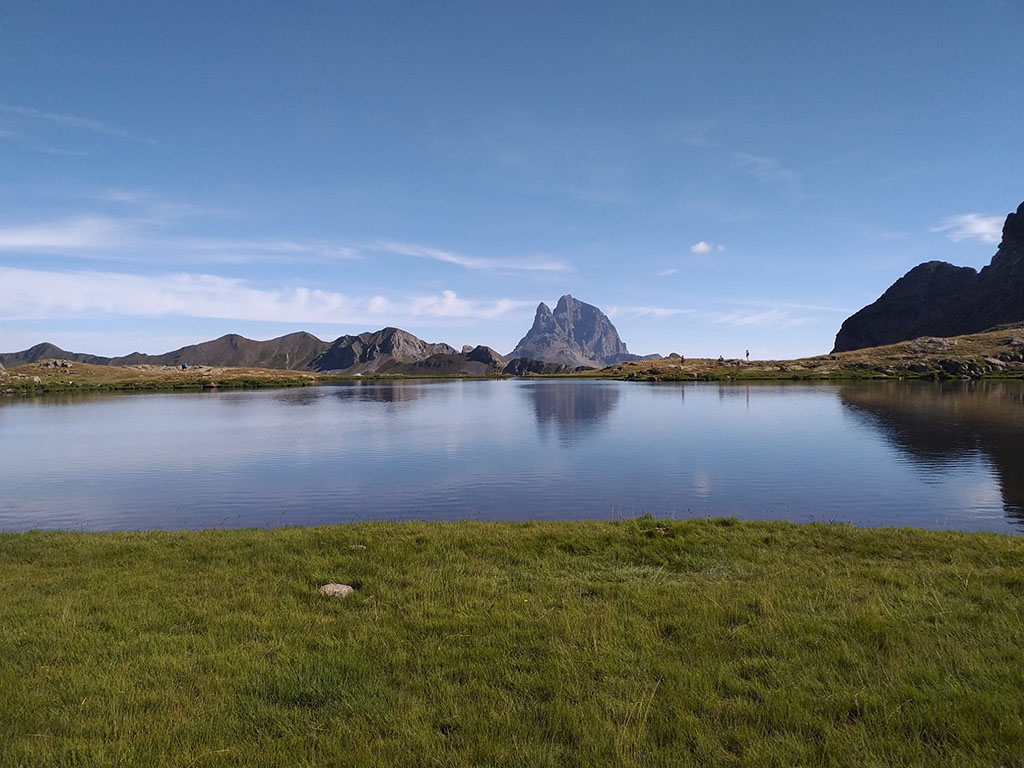
Tracks:
- The peak in the background of the photograph is the unmistakable peak of Midi d'Ossau.
- The photograph is taken from the GR11 route.
- Behind us are the remains of a volcano that half collapsed and only what is left of the chimney remains.
Solution:
This week's venue was the Anayet lakesone of those "obligatory" places to visit and a must for those who come to make the Pyrenean Path / GR11. The ibones are located at the foot of Pico Anayet (Buscamos#49), an ancient volcano that originated 300 million years ago, long before the formation of the Pyrenees between 85 and 24 million years ago.
We are looking for this place #65:
This week we set out to find out the name of this mountain. A rugged peak, devoid of vegetation, as befits a 3,000-metre peak.
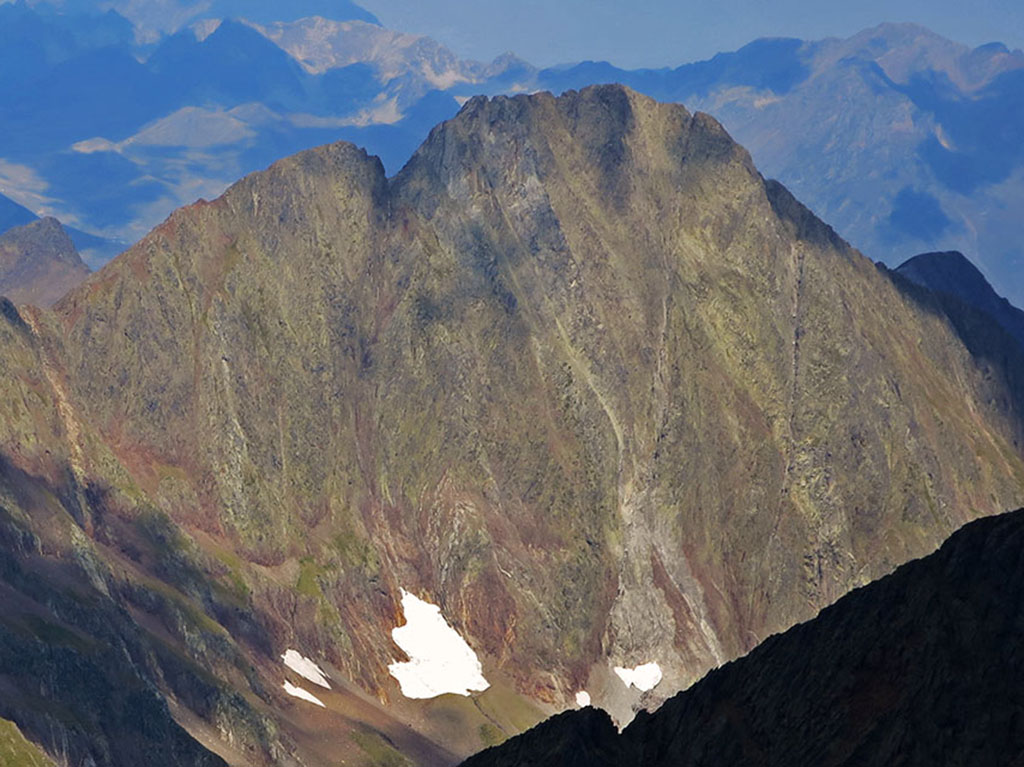
Tracks:
- It is a tresmil.
- It is the only 3,000m in this sector whose normal access is only from the French side.
- This clue is definitive, the photograph is taken from the Great Bachimala.
Solution:
The peak that we proposed to find out about last week was the Lustou (3,023m). The Lustou forms part of the Culfreda-Batoua group, within the sector of the Great Bachimala, but separated from them to the north of the Pyrenean axis. The most common route starts in the Rioumajou valley and is relatively unfrequented, bearing in mind that we are talking about a three thousand metre climb of some importance in an area, St Lary, which is very busy.
We are looking for this place #66:
This week we returned to the search for another "tresmil", the one sent to us by Nicola Crespí, a regular in this section, who added the following clues.

Tracks:
- They are two peaks of more than 3,000m linked by a very singular cornice.
- It can be climbed either via the Ball de Benás or the Vall de Barravés.
- Specular view of the Maladeta Massif.
Solution:
The two summits we were looking for in this week's photograph sent to us by Nicolau Crespí were the Tuca de las Culebras (3,054m) and the Ballibierna (3,060m). This is the best viewpoint on the southern slopes of the Maladeta massif. The photo is taken from the Llauset reservoir, from one of the most common access points to climb these peaks. We also told you on the slopes that both were joined by a very singular cornice, we were referring, of course, to the famous Paso del Caballo (Horse Pass).
We are looking for this place #67:
This week's photo was sent to us by Javier García, a photo he took a few days before while he was walking along one of the paths that run through the Parque Natural de los Valles Occidentales. He asked us to find out which dolmen it was.
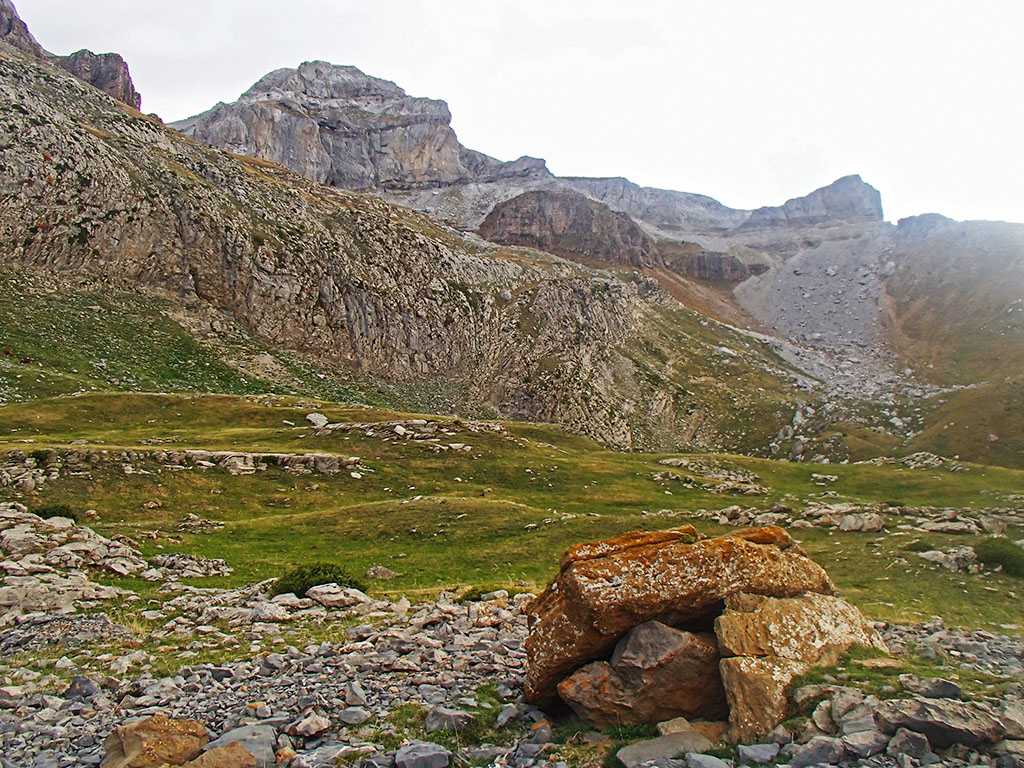
Tracks:
- It is located in the region of Jacetania, in the Valles Occidentales Natural Park.
- The dolmen is at the foot of the GR.
- Next to the dolmen there used to be a lake, but today it is more of a waterlogged area, as the basin is completely clogged.
Solution:
This is the Izagra dolmen, located in the Aísa valley in the upper part of the Igüer cirque. Archaeologically, it was discovered in 1990 and is the largest construction of its kind (a gallery with a diameter of 11.5m and a chamber formed by large blocks of reddish sandstone and a lid measuring 2.2 x 2.7m) in the valley.
We are looking for this place #68:
This week Nicolau Crespí proposed us to find an ibón, but not just any ibón, pay attention to the clues he sent us.
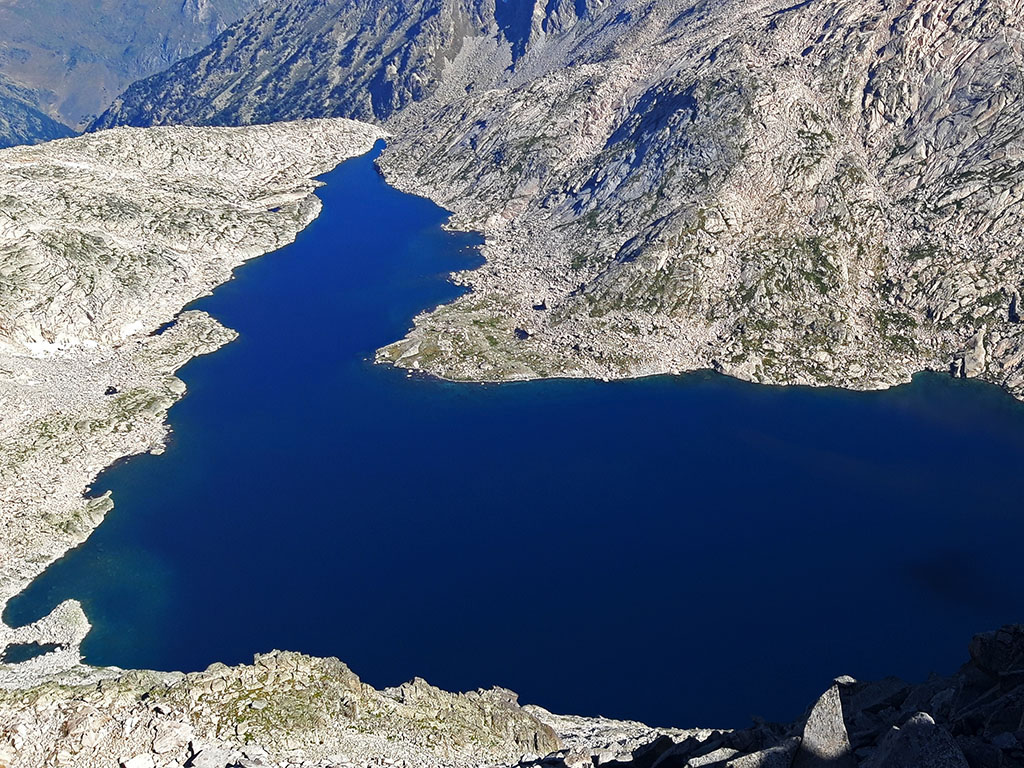
Tracks:
- The largest natural lake of glacial origin in the Aragonese Pyrenees.
- At its feet surrounded by a grandiose circus of three thousand.
- Called the giant of the Ibones.
Solution:
The place we were looking for was the Ibón de Cregüeña, the largest lake of glacial origin in the Pyrenees. It is located at an altitude of 2,593m, sheltered by the highest mountains in the Pyrenees, to the southeast of the Maladeta massif, in the Benasque valley. It is 1,500m long and 500m wide, with an extension of 45.4 ha and a depth of 96.9m. It is not for nothing that it is called the gingante of the ibones.
We are looking for this place #69:
This week we were not looking for one place but several. Can you tell us which peaks are in the picture?

Tracks:
- Almost all the peaks we see are over 3,000 metres.
- The main summit on the left is sure to have been the first three-thousander for many of you. It has the reputation of being one of the easiest three-thousanders in the Pyrenees.
- All the peaks are located entirely in Aragon.
Solution:
The peaks we saw in last week's photograph, taken on the ascent to Serrato (2,888m), were the Picos de las Argualas and the Picos del Infierno. In this small mountain area between Sallent de Gállego and the Balneario de Panticosa we can count up to 10 three-thousanders. From left to right the Argualas (3,042m), the Garmo Negro (3,064m), the Pico de Pondiellos (2,917m), the Arnales (3,001m) and the Infierno Oriental (3,079m) stand out.
We are looking for this place #70:
In this week's search we didn't ask you what you could see, but from where the picture was taken. Here are the clues!
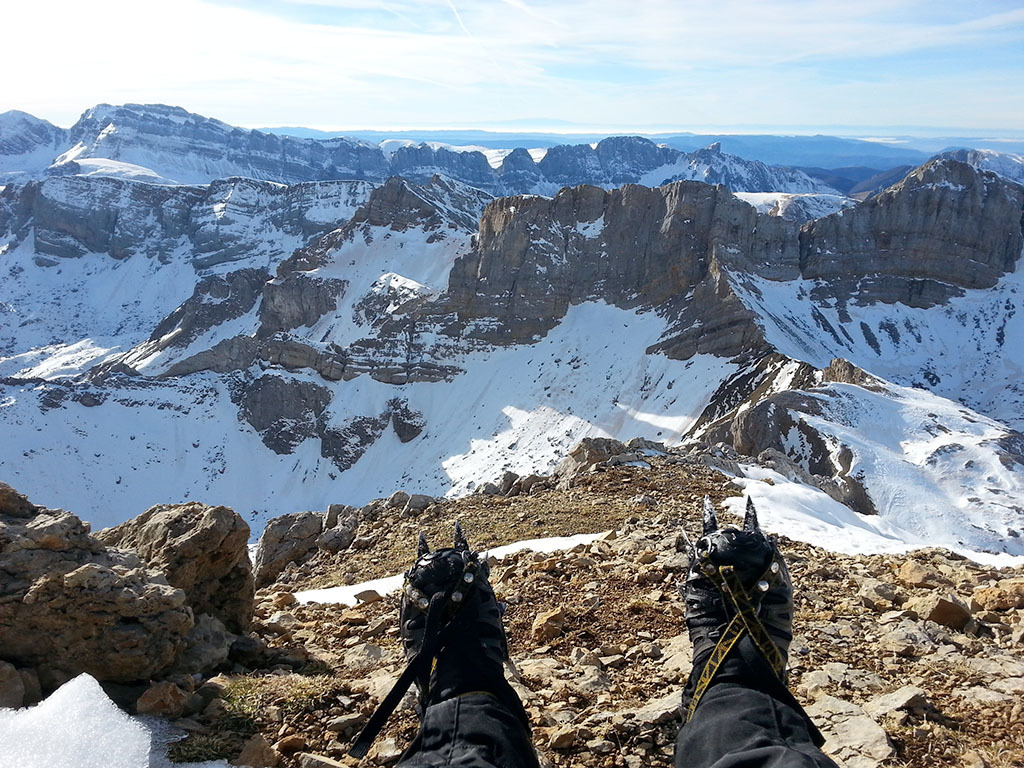
Tracks:
- We talked about the big barrier in the background of the picture a couple of weeks ago, when we climb to its two highest peaks.
- The one in the foreground, all the way to the right, was also discussed some time ago, when we climb it from Linza.
Solution:
Last week's photograph was taken from the summit of Acherito or Mallo de Acherito (2.374m), from where some time ago we brought you this one. circular route from Linzahighly recommended.
We are looking for this place #71:
This week we travelled to the eastern end of the French department of the Atlantic Pyrenees (Pyrénées-Atlantiques) in search of this great peak, or rather, set of peaks. Here are the clues.
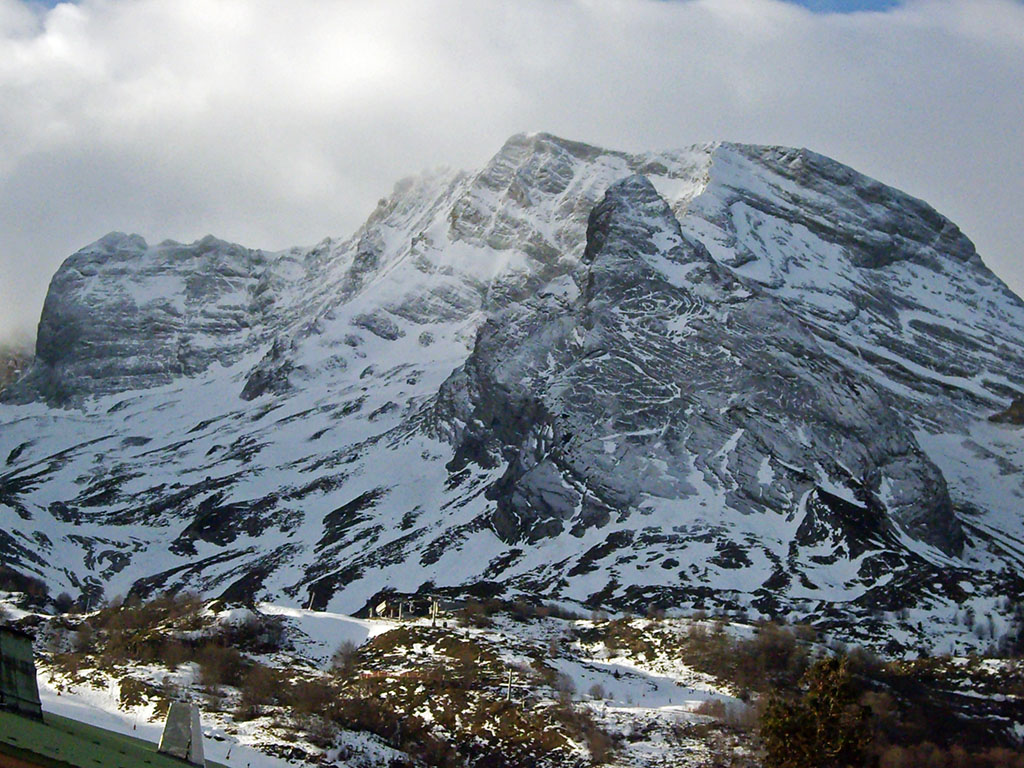
Tracks:
- The large flattened plates that unfold these peaks to the north, like a large mass of puff pastry, are their most representative feature.
- The photograph is taken from the ski resort at its base, which is accessed by the road to one of the most famous mountain passes of the Tour de France.
- The summit we are looking for is not the highest in the massif, nor even the highest in the surrounding area, but it is nevertheless the best known and most visited in the area.
Solution:
The peak in the centre of the photograph was the Pic de Ger (2,613m). The photograph is taken from the Gourette ski resort, which is accessed by the road leading to the famous col de l'Aubisque (1,709m). In the photograph, from left to right: Rognon de Ger (2,571m), Pic de Ger (2,613m), Salon de Ger (2,611m), Turon de Ger (2,533m) and the sharp spur of Les Coutchets (2,256m).
We are looking for this place #72:
The place we were looking for this week was sent to us by Patxitxo, a place that we love in winter or in summer, as at the time this photograph was taken. Let's take a look at the clues sent to us by Patxitxo.
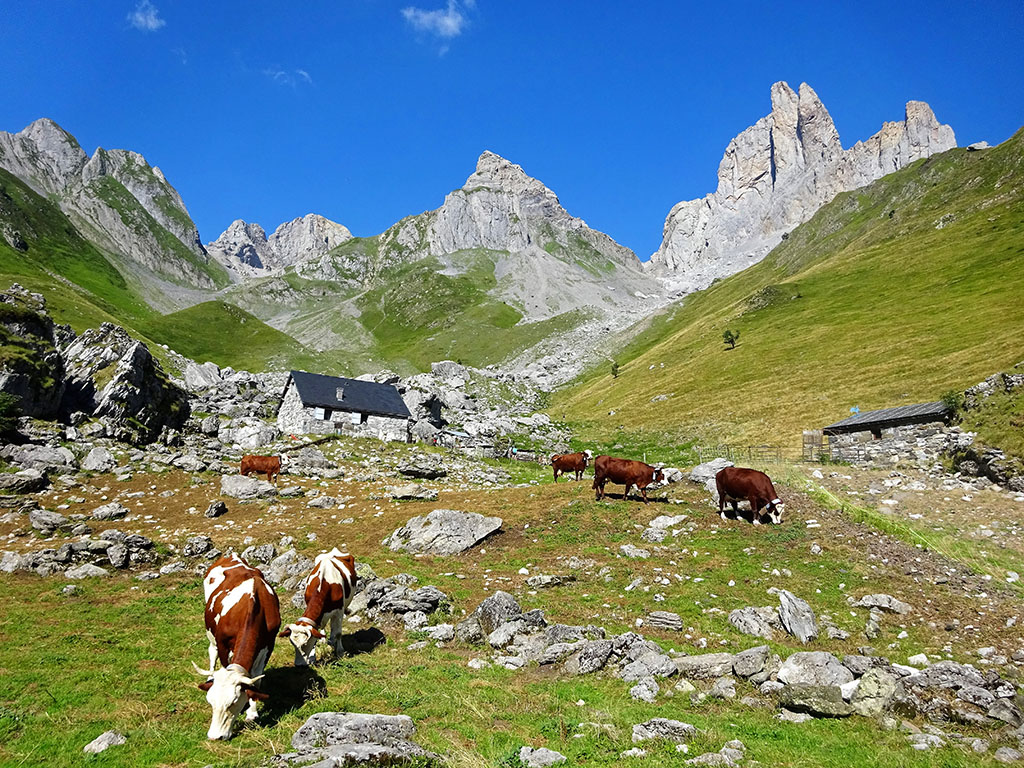
Tracks:
- Of the surroundings it has been said that "it is a picture-postcard landscape reminiscent of the dolomite mountains of the Alps or the Wilder Kaiser in Austria".
- It is located on French territory.
- The site is crossed by the Ruta de las Golondrinas.
Solution:
This week's photograph was of the Ansabère huts in the Lescún valley. A beautiful place that we never tire of admiring and which, as we said on the slopes, is sometimes compared to the Dolomites, the Wider Kaiser and whatever else it takes. The peaks that appeared behind us were from left to right: two of the three peaks of La Chourique (2,079m and 2,022m), the Mallo de Acherito (2,374m), Sobarcal (2,257m), the Petite Aiguille d'Ansabére (2,271m) and the Grande Aiguille d'Ansabère (2,377m).
We are looking for this place #73:
The GR11 or Pyrenean Path is the Gran Recorrido trail that crosses the Pyrenees from sea to sea along its southern slopes. In its more than 800 kilometres and almost 43,000 metres of accumulated height gain, the number of amazing places it crosses is incalculable, such as this one in the photograph. Do you recognise it?
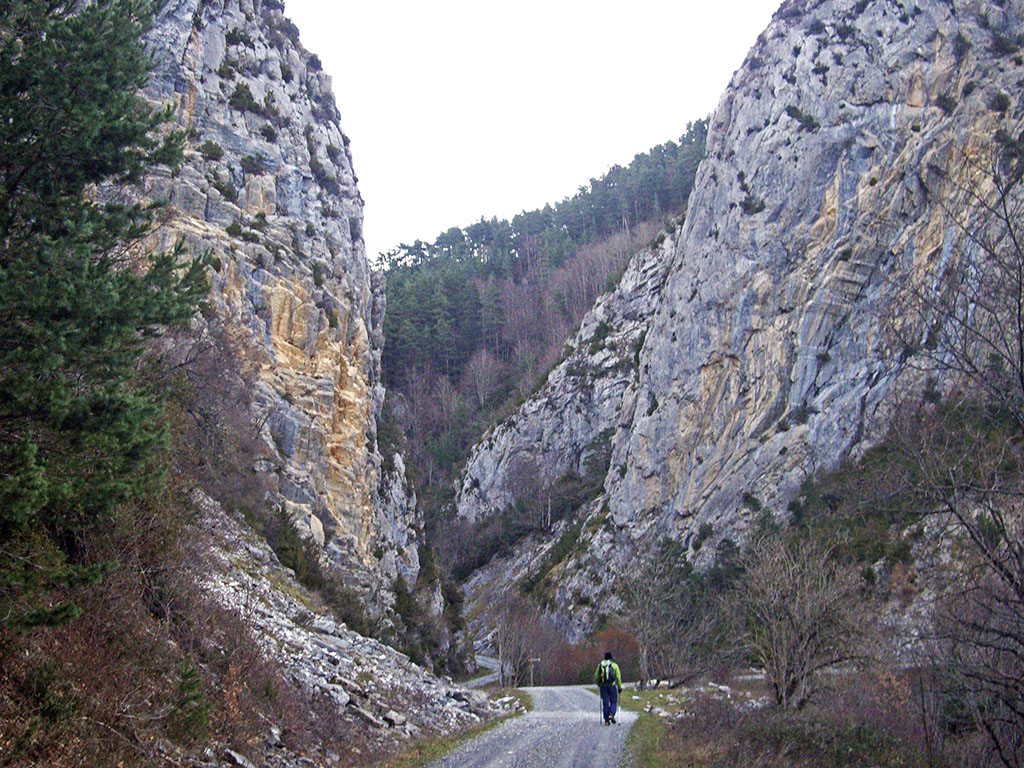
Tracks:
- It is located in the Navarrese Pyrenees.
- In front of this great natural pass the GR11 forks.
Solution:
Last week's photograph was of the Ateas de Belabarze pass, located just over two kilometres from the Navarrese town of Isaba. At this point the GR11 divides in two, crossing the two crags it follows the main route through the Belabarze valley, going up to Ezkaurre, the GR11.4 variant continues..
Fastpacking is not about going faster. It's about going lighter.
If you come from classic trekking, this is the next step: learning to move with less weight,
more fluid and enjoying every kilometre more.
Join the channel and start discovering what lightness feels like.
